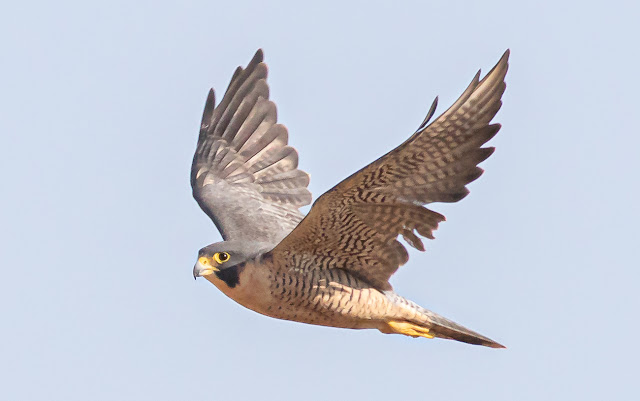A Sonoran Desert Spring Classic: the Tubac Hawk Watch
By Matt Griffiths

Gray Hawk, Matthew Studebaker
As winter becomes spring in the Sonoran Desert during the month of March, many people think of baseball diamonds and the return of the great American pastime. A visit to Ron Morriss County Park in Tubac at this time might prove otherwise as the baseball field is empty and the sidelines are filled with people watching for flying hawks instead of fly balls.
In a spring classic that's been occurring for untold generations, migrating raptors utilize our region on their way to locations further north. You might wonder why these birds would choose the seemingly sparse desert to travel through, especially since some of them have flown all the way from Argentina! The keys to this puzzle are the amazingly rich and diverse riparian areas that lie along the Santa Cruz and San Pedro Rivers. These two lush corridors are a part of the Madrean Sky Island region, an area of high mountain ranges and low arid valleys that has a species diversity rivaling any on earth due to its being a meeting point for multiple major ecosystems. It’s here that animals and plants of the Sonoran and Chihuahuan Deserts mix with those found in the Rocky Mountains and the Sierra Madre Occidental in Mexico. The two rivers are homes or stop-over points for 84 mammal species, 14 fish species, 41 reptiles and amphibians, and two-thirds of all the birds in the US, including roughly 100 species of breeding birds and 300 migrating birds. The cottonwood and willow riparian forests and adjacent mesquite bosque of the Santa Cruz and San Pedro Rivers are resource-rich oases in the desert where migrating hawks and other raptors can find food and places to spend the night on their long journeys northward.
The trickle of raptor migration begins in late February, and by the third week of March, the faucet of flying birds is turned on to full force! There are many places to view this avian spectacle, but the epicenter is undoubtedly Ron Morriss Park in Tubac. On most March mornings you will find groups of people discussing bird identification and peering into spotting scopes as each new wave of birds comes into view. The veterans of the scene don’t need optics most of the time and can tell a Common Black Hawk from a Zone-tailed Hawk from miles away. They can also help you figure out a bird—it’s a great learning experience! As can be imagined, this is a pretty happening social scene too.
.jpg) |
| The Hawk Watch is a pretty happening scene |
 |
| The Common Black Hawks are the stars of the show, Ned Harris |
The Hawk Watch leader will count and create a tally of all raptors for each day, from roughly 8 am until noon. Bring a chair and a hot beverage, and when the temps start to warm up a bit, watch as birds lift off from the tall cottonwoods in front of you to ride the thermal updrafts, sometimes passing right over your head! The Black and Zone-tailed Hawks will likely be the numerous stars of the show, but there will also be a healthy dose of Cooper’s Hawks, Swainson’s Hawks, and the many colorations of different types of Red-tailed Hawks—another great learning opportunity! Peregrine Falcons might zip by and an early Gray Hawk might call from the trees or fly over. You'll see large kettles of vultures, both Turkey and Black, and possibly a Golden Eagle will join the aerial parade above you. There are always a few surprises each year such as the recent juvenile Bald Eagle that excited folks, and the White-tailed Kite that flew by at the exact same time! When the birds and sightings get going at a frantic pace, people will be calling out birds left and right and you’ll really feel like you’re a part of something special.
 |
| Peregrine Falcon, Nick Pulcinella |
 |
| Zone-tailed Hawk, Ned Harris |
There are so many wonderful possibilities at the Hawk Watch, always a showcase of the wonder and importance of our desert riparian areas. Come and join the fun! Tucson Audubon will host migration celebration days March 16-20, 2024 at Ron Morriss Park in Tubac. Check out some new optics at the vendor booths and see the hawks for yourself! Learn more at tucsonaudubon.org/hawkwatch.
DETAILS: Parking is available inside the park, DO NOT park or congregate on the bridge! Local residents strictly enforce this. If the lot is full, you can park at the intersection of the road leading into the park and walk in.
Matt Griffiths is Communications Coordinator for Tucson Audubon.

Comments
Post a Comment
Thanks, we value your opinions! Your comment will be reviewed before being published.